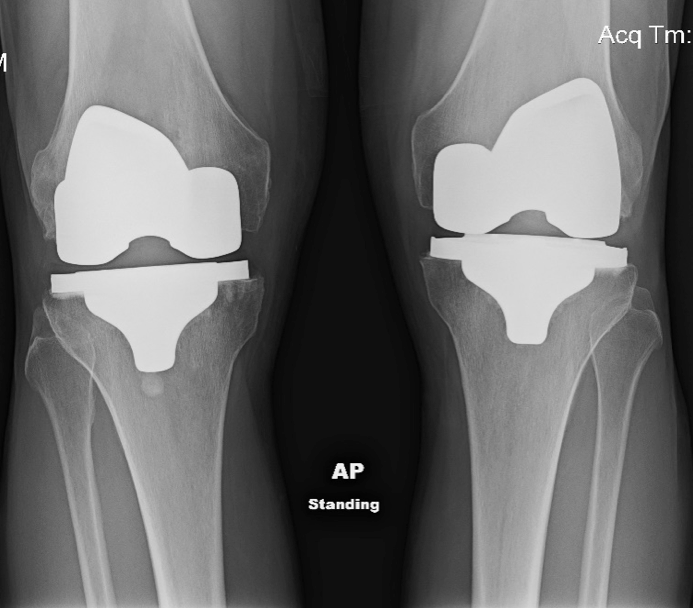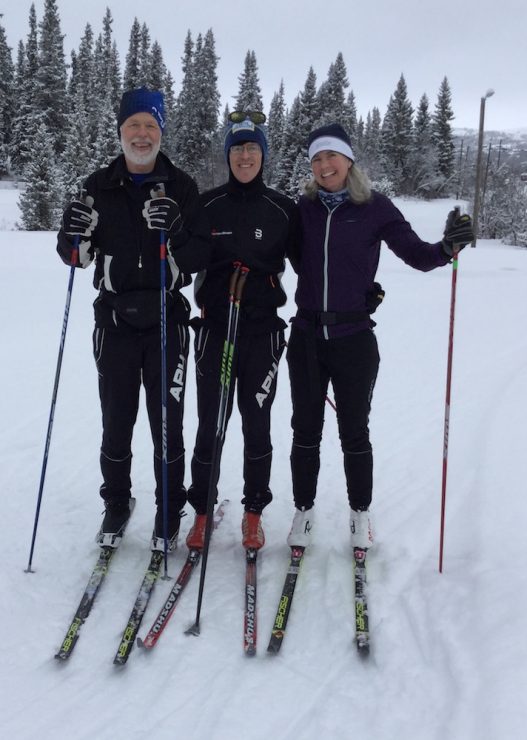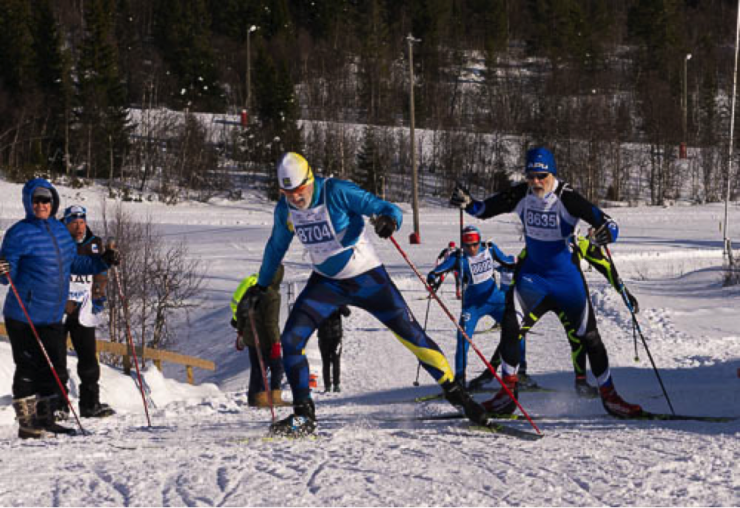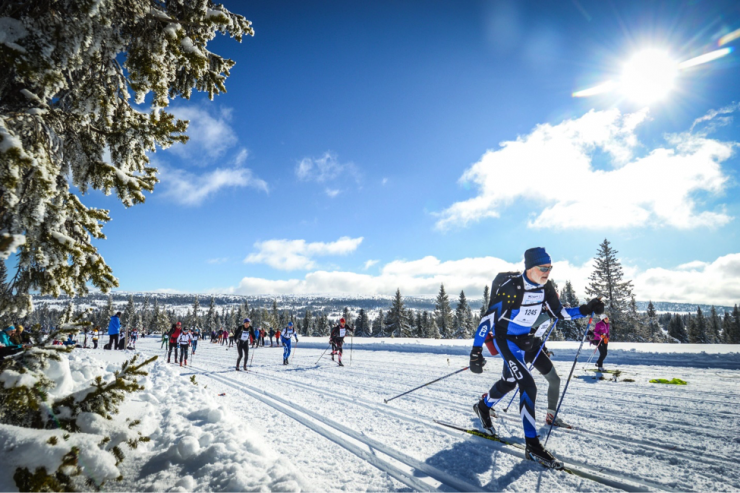
Editor’s note: John Wood is a septuagenarian racer who lives in Eagle River, Alaska, outside of Anchorage. Four years ago he wrote a first-person Masters Mind piece for FasterSkier detailing his return from a full knee replacement to winning his age group at the American Birkebeiner classic race 18 months later. This article provides an update on what happened next, including competing at the 2019 Masters World Cup in Beitostølen, Norway, following a second knee replacement.
This article is part of FasterSkier’s Masters Minds collection, an occasional series of dispatches from skiers aged anywhere north of 30. Are you a masters skier who loves your club? Submit camp or training recaps, announcements, or stories to info@fasterskier.com with the subject line “Masters Minds.” Articles can be first-person accounts, or written from an observatory standpoint with comments from others.
* * *
By John Wood
I have skied three competitive cross-country relay races in my life.
The first was at the 1965 Junior Nationals in Bend, Oregon, where I represented the Alaska Region. The second was at the 1989 U.S. Masters National Championships in Telemark, Wisconsin, where I also represented Alaska. The third, when I was 71 years old, was this March at the 2019 World Masters Cross Country Championships in Beitostølen, Norway, where I represented the USA in the M9 age class for skiers aged 70–74. A fact unknown to my international competitors in Norway was that I was skiing on two recent total knee replacements, which is the rest of this story.
In April 2015, I wrote an article in FasterSkier explaining how my right knee wore out, was replaced in 2013, and how I recovered and won my age group in the 2015 American Birkebeiner. In early summer 2015 I was feeling really good about my recent Birkie and decided that I should “defend” my age group win. So I signed up for the 2016 Birkie and made my travel and housing arrangements.

As the summer progressed and turned into fall my left knee, which I had relied upon for all of those years that my right knee was bad, now had to “keep up” with my new artificial right knee that could go like gangbusters while participating in such activities as hiking, rollerskiing, and snow skiing. My doctor had told me prior to my right knee replacement that my left knee was also pretty much worn out and would also need to be replaced at some point in the future, and he was right! Over about a month it began to swell, click, and generally make my life miserable. Doctor Eli Powell at Orthopedic Physicians Alaska in Anchorage confirmed my suspicions, and we scheduled surgery on the left knee for January 2016. My Birkie plans went out the window.
Dr. Powell’s total replacement of my left knee with a Stryker “Triathlon Total Knee System” on January 14, 2016, was uneventful from a medical point of view. I was discharged two days later, and my life on two artificial knees began. First order of business was surgery rehab.
Initially, the recovery path paralleled my right knee replacement 2 1/2 years earlier. I quickly progressed from full-time crutches, to part time, to no crutches at all by day 23. An interruption came when I was jolted awake by a magnitude 7.1 earthquake in the middle of the night on day 11. As I tried to jump out of bed my wife literally pushed me back down, afraid I would stumble and fall in my medicated/disoriented state. Fortunately, the violent shaking duration was short and our house undamaged.
Physical therapy progressed smoothly, and I reached the gold standard of a 120-degree knee bend on day 30. Other milestones followed in succession: first 15-minute outside walk, first drive to town, suspension of pain meds, and, blessedly, a full night’s sleep. I did my first half-hour ski on level ground on day 67, and was discharged from physical therapy on day 68.
As the days went by, the soft tissue surrounding my left knee and atrophied leg began to strengthen. Some days felt better than others. My left hip began to protrude, the first visual lingering effect of a body imbalanced and overcompensated by long-term bad knees that had finally been corrected. I experienced lingering aches and soreness in the left knee area after exercise or just standing around. I began to resort to an over-the-counter knee brace. Over the course of the summer the puffiness in the knee gradually decreased, as did my knee brace use. At about 9 months post-surgery I was able to complete a 3 hour hike up and down Mt. Healy with my 10-year-old grandson.
When snow came in November and I returned to skiing, using a knee sleeve and compression tights, I experienced a knee “sting” that would dissipate in the evening. At my one-year post-op visit, the doctor said that my x-rays looked great, and I was discharged. I received the usual advice that I could participate in all the physical activities that I wanted, except for contact sports and running, and that pain and discomfort should be my limiting guide. I was further counseled that my residual pain should recede, and I should try to function with minimal knee support.

For the rest of the 2016/2017 winter I competed in a couple of my favorite local ski races, although fitness was an issue. Also, I experienced lapses in proprioception caused by my knee’s replacement – I would plant a pole on a ski and suddenly fall.
In April 2017, about 15 months after the replacement, I begin to see Dr. Zuzana Rogers, P.T., to receive treatment for lingering body imbalances, proprioception issues, and muscle pains in my left knee area. Dr. Rogers skillfully diagnosed the root cause of most of my problems and devised specific physical therapy routines as treatment.
During the period from summer 2017 till spring 2018, I continued to recover from the lingering effects of surgery and long-term body imbalances. My strength was slowly coming back, although much slower than with my previous right knee replacement. I discovered that my body’s immune system was not as stellar as it was prior to the two knee replacements. I was now susceptible to all the garden variety colds and flus that I never used to get. Through trial and error I discovered that a good antidote was to stay more rested by taking one or two days per week off from systematic training. In other words, train smart!
In early April 2018, my wife Cathy strongly encouraged me to enter the 2019 World Masters Cross Country Ski Championships (“WMC”) to be held in Beitostølen, Norway. I decided if I am ever going to enter the WMC, I might as well go to the birthplace of cross-country skiing and compete with the world’s best!
I immediately contacted John (J.D.) Downing, American Cross Country Skiers (AXCS) national director, and signed up to be part of the United States contingent for Beitostølen. This enabled me to take advantage of all of the AXCS trip planning such as housing, meals, and all of the racing logistics. With the help of APU Masters coach Galen Johnston, I developed a training program based on about 450 training hours per year (I had loosely been doing about 350 hours per year prior to coping with knee replacements for the last five years), and integrated solo training alongside three formal group workouts a week with the APU Masters group.

Galen and I tried to design a program that worked within the challenges imposed by two artificial knees. With swelling and aching no longer a problem, we tried to place an emphasis on fitness and ski-specific strength. Sometimes my knees would feel cranky and tell me to take an extra day off or dial back on the intensity of my workouts. I needed to further balance my training hours with weather fluctuations, family commitments, and rest. This often involved walking a fine line!
My typical summer training week was one day of strength and four or five days of a combination of hiking with poles, modified ski bounding, rollerskiing, road biking, and mountain biking, including one intensity session per week. I attended a four-day APU Masters Eagle Glacier training camp in July. [Ed. note: Or, as it happened, a five-day training camp, after all the athletes were weathered in for an additional 24 hours due to high winds.]
On-snow training began on October 30, 2018, following the first substantial snowfall in southcentral Alaska. A typical on-snow training week consisted of one day of strength and four or five days of skiing, one of which was intensity. Overall, early-season snow conditions in the area were pretty good. Local racing started in December; I competed in six events ranging in distance from 5 to 30 kilometers, and the results were encouraging. My training continued to go well, and by March I was as fit as I was going to be!
During the middle of the winter Zuzana Rogers also helped with a final tune-up of my body imbalances and proprioception issues, which had improved substantially over the last year.
As World Masters approached, the scope of the event took shape. There would be about 1200 competitors from 28 nations in attendance and about 120 competitors in my M9 age group. Two other “younger” skiers from my APU Masters group were also going, as well as about a dozen other Alaskans.
At the advice of APU head coach Erik Flora, I arrived in Norway a few days prior to the AXCS main 200-person contingent in an effort to get my body used to the 10-hour time change from Anchorage. Night was day and day was night!

The “resort” town of Beitostølen is in the foothills at about 3000 feet in elevation, and is at almost precisely the same latitude (61 degrees north) as Anchorage. The town’s official permanent population of 400 annually hosts World Cup or FIS-level competitions, and seemed to seamlessly accommodate the thousand-plus athletes of the WMC contingent that descended upon it in early March. It seemed like all 200 American skiers were staying at or near the Radisson Blu hotel in central Beitostølen and eating meals there, and it was fun to see and chat with my fellow American teammates every day.
February weather in Beitostølen had been quite warm, and the snow had settled to a hard, dirty snowpack. Fortunately, the weather changed literally as my bus drove into the Norwegian mountains out of Oslo and it began to snow. It continued to snow almost daily for my entire 18-day stay, creating great skiing and easy wax conditions.
My first competition was the 15-kilometer classic race. Because of my results in the 2015 American Birkebeiner classic, I had a few “seed” points that put me ahead of other first-time racers, so I was able to start in the front third of the M9 chevron.
As 56 competitors assembled prior to race start it was hard not to be intimidated by the number of fast-looking, spandex-covered skiers speaking foreign languages. Many were veterans of previous World Masters races and friends with each other, and I couldn’t understand a word of what they were saying! But, even though I was a World Masters rookie, I was excited because I was finally going to test my fitness level and new knees against the world’s best M9 skiers.
After the starter’s gun went off it was a mass sprint for the stadium end and start of the double-track racecourse. My APU Masters group had been working on race warmups and starts, so I felt well prepared to surge. I ended up in a good position at the end of the stadium, but was immediately engulfed by a wave of skiers heading onto the trail at an all-out race pace effort.
Our club has a loose motto of “no guts, no glory,” so I too headed off at a crazy fast-paced tempo trying to stay in the mix of front skiers. I soon realized I had to back off a bit and ski within myself, work my technique, and ski to my strengths. At every change in terrain I would mentally check my knees, then check the technique, and finally the effort. Did I need to back off, maintain, or crank it up?
The 15 k racecourse consisted of three separate 5 k loops and was covered with skiers from the M7 and M8 races, as well as some stragglers from the day’s first six races. Some skiers were faster and some slower, and in my maximum-effort tunnel vision it was impossible for me to tell how I stood in my age group wave. Near the end of the race there were some long, steep uphills, where I passed a number of skiers. I later learned that I had ultimately finished in eleventh place in the M9 race, one second out of tenth.
Wow! What an effort at a crazy fast pace, and the knees came through in fine shape! Those front guys sure could ski fast! I kept asking myself what was I doing wrong that I couldn’t keep up? [Ed. note: Wood was the top American in this race, by nearly five minutes. His finish in the 15 k classic was the single best percent-back performance by any of his APU Masters teammates in the entire race series.]
After coming off that emotional high it was time to rest – eat – rest some more, and mentally prepare for the next event. Everybody in the USA contingent had a race story to tell and it was fun to compare notes. We were all in awe of the high level of competition and the continuous all-out effort needed to be competitive. European guys and gals play for keeps!
Two days later I competed in the 10 k freestyle race. I have only been able to really skate ski since my second knee replacement, and had no illusions. My technique was sketchy but improving, and I figured that since I was at the WMC I should compete in a skate race. My goal was to have a clean run with maximum effort, regardless of finishing position.
As the race began, skis and poles were flying everywhere so I let the fast guys go by and settled into a sustainable rhythm. Nearing the end of the race, after successfully negotiating a sharp turn at the bottom of a screaming downhill, I felt I was doing pretty good and congratulated myself on a job well done. Time to transition from V2 to V1 and drop the hammer on the last uphill into the stadium. Out of the blue, proprioception struck. I planted my right ski pole on my right ski, and went down in a heap! I had been skiing at the head of a loose pack of five, and suddenly found myself in the middle and out of steam. Needless to say, I finished at the back of the group in 24th place.

I had qualified with Team USA to ski either classic or skate in the relay midway through the race week, but quickly removed my name from consideration for the skate leg. Didn’t want to have more proprioception difficulties in the relay with three teammates counting on me!
JD chose me to ski the scramble leg, which was the first of two classic legs in the 4 x 5 k relay. At our team meeting prior to the race, my teammate and World Masters veteran Phil Mahoney confided to me that I should not feel bad if I couldn’t keep up with the pack since the world’s best M9 skiers were also skiing in the scramble leg. I was a bit intimidated, but this was why I came to World Masters, to compete with my age groups best, and I was determined to give it my all! Fifteen skiers representing fifteen teams (between M9 and M10 combined) were in my wave start, and when the gun sounded the adrenaline hit and off we went!
I was third at the end of the stadium and maintained fourth through most of the 5 k lung-burner. Approaching the stadium, in spite of JD’s vociferous cheering, I slipped a couple of places and tagged off to Phil 25 seconds out of third. I was so spent that I just about fell over. My knees did great; during the race, I never gave them a thought. Just all-out racing.
The next morning, I discovered that the light cold I had developed had turned into a nasty head cold that left my nose running like a spigot. My immune system apparently couldn’t take the stress of back-to-back top level competitions. I skipped that day’s 30 k classic race and hoped an extra day’s rest would help me feel better for the 55 k Norwegian Birkebeiner, three days later and a couple hundred kilometers away.
On the morning of the Birken, my cold symptoms seemed minimal and I felt better. As my 70-and-older wave started, I went out with the lead group up the initial 10 k sustained climb heading out of Rena. Big Mistake!! I ran out of gas after about seven kilometers, my nose started flooding again, and I was forced to ski at what seemed like a crawl until about 17 k to go, when I picked up after drinking a cup of Coke at a feed station. I skied conservatively on the long downhills approaching Lillehammer, since I was unfamiliar with the course and didn’t want to fall. Boy, was I happy to cross the finish line, and was really surprised when I learned that I had finished in the top third of my age group.

After a day of recovery in Lillehammer I returned to Anchorage, a 27.5-hour trip home. My World Masters adventure had concluded and my new knees came through with flying colors. I had met my goals of being first American and in or near the top half of my age group in all 4 races. As icing on the cake, in three out of the four races I was the first North American skier in my age class.
It’s now summer in Alaska, the snow is gone, and the skis are put away. It’s time for mowing the grass and paddleboarding in the lake. And it’s time for reflection. Having your knees wear out and being replaced doesn’t necessarily mean the end of a person’s lifestyle. It’s all about knowing and understanding the limits of your new knees and working within these limits. Do what you want to do.
It would be fun to do the World Masters Championships again someday. I now know that my new knees are not my limitation. Maybe I could figure out a way to tweak my training to take my performance up a notch. Maybe my competitors would get old and slow down a bit. Maybe, maybe…
John is a 72-year-young master skier who has lived in Alaska since before statehood. He has competed in cross-country skiing intermittently since being introduced to the sport at age 16 while in high school by the legendary coach and skier Dick Mize.



